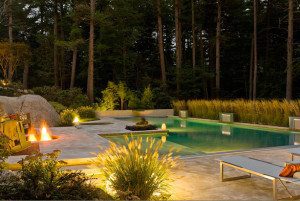Repeat Performance: Textile Designer Ellisha Alexina
July 19, 2016
Textile designer Ellisha Alexina’s subtle playfulness with color results in fabrics whose recurring patterns manage to be both calming and dynamic.
Text by Louis Postel
The eye moves up the curtain in search of where its pattern repeats. Finding repeats becomes a kind of game. Where to find the next line of flowers, leaves, or inky down-strokes? It becomes a visual game that can quickly become tiresome. As a reflection of consciousness itself, patterns that are too chaotic make us anxious, just as patterns that are too uniform and predictable cause our focus to wander. What we want from consciousness and maybe from textile patterns, too, is just to flow.
And if flow is the goal, who can help us in the home furnishings department? Enter Ellisha Alexina, a twenty-seven-year-old textile designer in Easthampton, Massachusetts, who has broken through to the highest ranks of the design industry with a mixed-media process that combines hand painting and polychromatic printing. Neither rigid nor reckless, Alexina’s patterns allow consciousness to expand and breathe freely.
“Even back in high school I was always interested in pushing the boundaries of process in art,” Alexina says. “I recall taking rubber cement and painting over it, removing the cement and reapplying it. Or wetting the paper first before drawing with charcoal. At fourteen I knew that this was not a hobby, but something I wanted to do in life.”
Designers and showroom owners—Gauthier-Stacy and Jennifer Palumbo in Boston, Holland & Sherry in New York City and Los Angeles, and Travis & Company in Atlanta—are all asking the same question of Alexina: “How did you do that?”
Not even her greatest champion and neighbor, the celebrated textile designer Peter Fasano, can explain quite how Alexina does what she does to make the repeats seemingly nonrepetitive by subtly manipulating color. If she were doing flowers, no two flowers would be the same, and yet they would always repeat. The pattern would remain consistent, whether in three yards or thirty. Alexina’s designs can’t really be fully appreciated as small samples. They have to be seen as yardage, the better to appreciate their shimmering, liquid qualities, like sunlight mottling a lake’s surface.
“In college I was experimenting with textile patterns, modulating colors, obscuring the beginnings and endings of these ten-inch repeats,” she says. “I brought a few yards to Fasano. He said, ‘You need to start your own business, because no one is doing what you are doing right now. If you can continue this in a professional way with a studio that can produce in scale, you will succeed.’ And that’s what I did, putting some samples in a bag and walking around the D&D in New York City during market, introducing myself and the samples. ‘How did you do that?’ they’d say, and some would buy—this was in 2013.”
Now Alexina, who earned a BFA in textile design and fiber arts from the University of Massachusetts, Dartmouth, is outgrowing her studio, with its cylinder-stack pyramids of Belgian linen in the hundreds of yards, and rows of nontoxic, colorfast pigments. There you can see samples of her two main collections, Mendel and Vedana, in all their various colorways and patterns. Mendel, her first, references delicate textile fragments and hand embroideries of seventeenth- and eighteenth-century Ottoman motifs. They’re tight and rhythmic, with an impact that is both soft and refreshingly animated. Also within the Mendel collection is the Alexina Stripe pattern. In the fabric’s full fifty-one-inch width, the stripes lure you into a dream forest that’s hard to leave.
In contrast, Alexina’s Vedana collection features looser patterns and larger repeats. Vedana is the Sanskrit word for feeling or sensation, the essence of astronomical twilight. The Novella pattern expresses this twilight story in an abstract, leafy way. “It’s about as bold as I tend to get,” says Alexina. Novella’s companion Mano, or Mind, is a vertical, grid-like pattern, an array of abstract neurons, no two exactly alike, swimming up to some softly illuminated, undefined surface, a depiction of consciousness itself when said to be most in the flow.
New England can take pride in the creator of all these unique and subtle patterns, patterns that soften the repetitive nature of repeat that has existed for tens of thousands of years in hundreds of different cultures. We can take pride and at the same time leave off shaking our collective heads: How does she do it? •
Ellisha Alexina
Easthampton, Mass.
(413) 527-0709
ellishaalexina.com
Share
![NEH-Logo_Black[1] NEH-Logo_Black[1]](https://b2915716.smushcdn.com/2915716/wp-content/uploads/2022/08/NEH-Logo_Black1-300x162.jpg?lossy=1&strip=1&webp=1)












You must be logged in to post a comment.